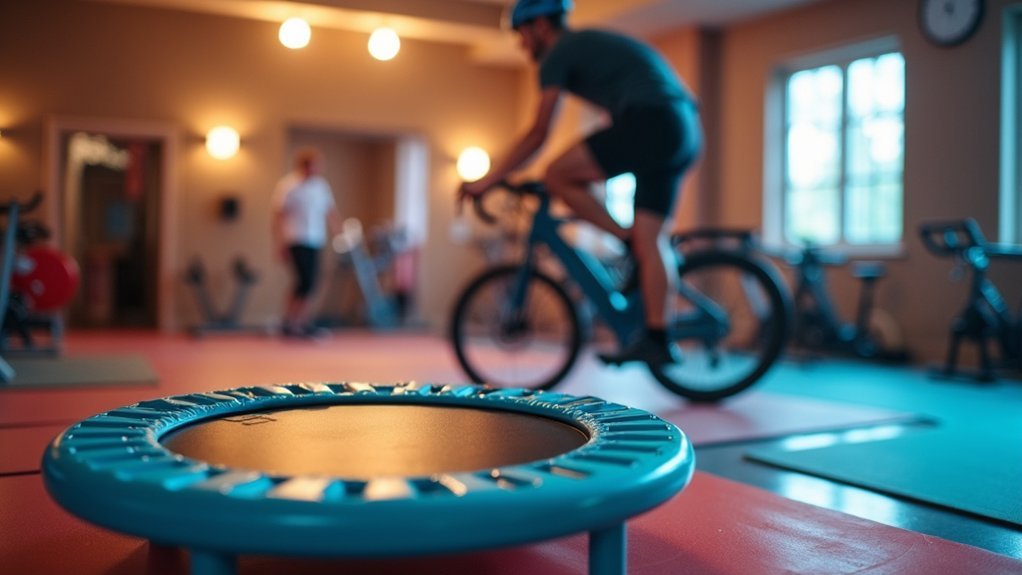Mini-bouncing offers gentler joint impact than cycling, absorbing up to 87% of impact forces. While cycling burns more calories overall (500/hour vs 250-400/hour), rebounding engages multiple muscle groups simultaneously for full-body toning. Both improve cardiovascular health, but mini-bounces maintain higher heart rates due to full-body engagement. Rebounders are more accessible, requiring minimal space and setup compared to bikes. You’ll likely stick with mini-bouncing longer due to its enjoyment factor and lower joint stress. Let’s explore each benefit in detail.
7 Best Mini-Bounce Vs Cycling Cardio Benefits

While both mini-bounce workouts and cycling offer excellent cardiovascular benefits, they differ markedly in their impact and overall fitness advantages.
When choosing between these workouts, consider how mini-bounce provides a Low-Impact alternative that’s gentler on your joints compared to cycling’s repetitive motion.
Though cycling burns approximately 500 calories hourly versus the 250-400 Calories Does Rebounding Burn, mini-bouncing delivers unique benefits beyond calorie expenditure.
Rebounding enhances both heart health and lymphatic circulation—something cycling doesn’t specifically target. This detoxification benefit gives mini-bouncing an edge for those seeking all-encompassing wellness.
Additionally, mini-bounce engages your entire body while incorporating strength movements, whereas cycling primarily works your lower body muscles.
The enjoyable nature of rebounding might keep you more consistent with your fitness routine compared to cycling’s potential monotony.
Impact on Joints and Injury Prevention
Joint health plays a central role when evaluating cardio exercise options, and in this aspect, mini-bounce and cycling present distinct profiles.
Mini trampoline workouts offer considerably gentler impact on your joints compared to cycling, which can still stress knees and hips during intense sessions.
Bounce your way to healthier joints while cycling enthusiasts contend with potential knee and hip strain.
The unique shock-absorption properties of rebounders make them excellent for injury prevention while delivering an effective cardiovascular workout. You’ll find this especially beneficial if you’re managing joint issues or recovering from injuries.
- Mini trampolines distribute impact evenly throughout your body, reducing strain on specific joints.
- The elastic surface absorbs up to 87% of impact forces, protecting your skeletal system.
- Low-impact rebounding strengthens joints and surrounding muscles without the overuse risks associated with cycling.
Choose mini-bounce for joint-friendly cardio that doesn’t compromise effectiveness.
Calorie Burning Efficiency Comparison

When comparing mini-bouncing to cycling, you’ll find calorie burn rates differ considerably—rebounding typically burns 250-400 calories hourly while cycling averages around 500 calories.
Your body weight impacts these numbers, as heavier individuals can burn more calories during rebounding sessions, potentially narrowing the efficiency gap between the two activities.
During high-intensity rebounding, you can achieve up to 12.4 calories burned per minute, making it a surprisingly competitive cardio option when you push your workout intensity.
Calories Per Minute
Two key factors separate mini-trampoline rebounding from cycling when it comes to calorie-burning efficiency.
Rebounding delivers impressive calories per minute, burning up to 12.4 calories during high-intensity options compared to cycling’s 8.3 calories at moderate pace. This efficiency makes rebounding particularly valuable for weight loss when you’re short on time.
- High-intensity rebounding (12.4 cal/min) outperforms moderate cycling (8.3 cal/min) by nearly 50%, making it more time-efficient.
- Even low-intensity rebounding (6.9 cal/min) remains competitive with easier cycling sessions.
- Heavier individuals burn more calories during rebounding workouts, especially at higher intensities.
Your weight considerably influences calorie burn during rebounding, with higher body weights creating greater energy expenditure.
When intensity levels increase, the calorie-burning advantage of rebounding over traditional cardio becomes even more pronounced.
Workout Intensity Effects
Although both exercises deliver considerable calorie-burning benefits, the intensity of your workout dramatically shifts the efficiency equation between rebounding and cycling. At moderate intensity, cycling burns more calories overall—about 500 per hour compared to rebounding’s 250-400.
However, when you examine shorter sessions, the comparison changes. Low-intensity rebounding burns approximately 65 calories in 10 minutes, while high-intensity rebounding jumps to 87 calories in the same timeframe.
Cycling typically burns 200-350 calories in 10 minutes, making it more calorie-intensive.
The workout intensity you choose matters considerably. If you’re seeking joint-friendly exercise that still delivers caloric benefits, rebounding offers efficiency in shorter bursts.
You might find yourself exercising longer on a mini-trampoline due to reduced impact and increased enjoyment—potentially equalizing the calorie burn advantage.
Muscle Engagement and Toning Effects
Despite their similar cardiovascular benefits, mini-bounce workouts and cycling differ markedly in their muscle engagement patterns and toning effects.
While cycling primarily targets lower body muscles, rebounding offers a more thorough approach to muscle toning through full-body engagement.
- Full-Body Activation – Mini-bounce workouts engage multiple muscle groups simultaneously, including calves, quads, hamstrings, glutes, and core, providing superior overall toning compared to cycling’s lower-body focus.
- Functional Strength Development – The varying intensities during rebounding improve muscle strength and endurance while enhancing balance and coordination—benefits less emphasized in cycling routines.
- Versatile Movement Patterns – Rebounding allows for incorporating strength exercises like squats and lunges, creating a more extensive toning effect while remaining low-impact on your joints.
Cardiovascular Health Improvements

Both mini-bounce workouts and cycling push your heart rate into ideal training zones, with mini-bouncing potentially maintaining higher rates due to its full-body engagement.
You’ll build endurance capacity faster with either activity when performed consistently, though mini-bouncing’s combination of resistance and cardio elements offers unique advantages for cardiovascular stamina.
The rhythmic nature of these exercises improves your arterial elasticity over time, with mini-bouncing’s vertical movement pattern creating beneficial circulation effects that may enhance vascular health more thoroughly than cycling alone.
Heart Rate Zones
When targeting ideal cardiovascular fitness, understanding heart rate zones becomes essential for maximizing your workout benefits. Mini-bouncing excels at quickly elevating your heart rate into moderate-to-vigorous zones, comparable to running at six miles per hour, while cycling typically maintains a steadier cardio state.
- Zone targeting – Mini-bouncing can rapidly push your heart rate higher than cycling, making it effective for interval training and maximizing cardio efficiency.
- Fat-burning potential – Monitoring your heart rate during both activities helps you stay in prime fat-burning zones (60-70% of maximum heart rate).
- Long-term adaptation – Regular mini-bouncing sessions improve heart rate variability and aerobic capacity more markedly than traditional cycling workouts.
Endurance Capacity Enhancement
Moving beyond heart rate zones, we need to examine how these exercise methods translate into lasting cardiovascular improvements.
Both mini-bouncing and cycling effectively build your endurance capacity through consistent cardiovascular challenges.
Mini-bouncing delivers moderate-to-vigorous intensity workouts comparable to running, strengthening your heart while supporting your lymphatic system—a vital factor in long-term cardiovascular health.
The rebounding motion uniquely enhances circulation in ways that complement traditional cardio training.
Meanwhile, cycling burns approximately 500 calories per hour at moderate intensity, systematically building your stamina through sustained effort.
Your cardiovascular system adapts by becoming more efficient at oxygen delivery.
Regular participation in either activity will reduce your risk of heart disease while progressively extending your endurance threshold.
The key is consistency—whether you choose bouncing, cycling, or alternating between both.
Arterial Elasticity Benefits
Beyond calorie burning and endurance gains, your arterial health dramatically improves through consistent mini-bounce workouts.
Rebounding exercises increase arterial elasticity, enabling your blood vessels to expand and contract more efficiently. This enhanced flexibility directly supports cardiovascular health by improving circulation throughout your body.
When compared to cycling, mini-bounce activities provide:
- Superior endothelial function – rebounding stimulates the inner lining of your blood vessels, reducing cardiovascular disease risk
- Enhanced oxygen delivery – the dynamic movements improve circulation, delivering oxygen more effectively to tissues
- Lower blood pressure – regular bouncing reduces strain on your cardiovascular system through improved arterial compliance
Your arteries benefit remarkably from the unique movement patterns in rebounding, which engage more muscles and create a more thorough cardiovascular response than cycling’s repetitive motion.
Accessibility and Convenience Factors
Although both exercise options offer cardiovascular benefits, mini-bounce and cycling workouts differ considerably in their accessibility and convenience.
When you choose mini-bounce workouts, you’re selecting an exercise that can be performed indoors on a rebounder regardless of weather conditions, while cycling often requires either a stationary bike or safe outdoor routes.
The compact nature of rebounding makes it ideal if you’re living in a small apartment or have limited home gym space.
You’ll appreciate how lightweight and portable a rebounder is compared to a bulky stationary bike.
Mini-bounce workouts also fit seamlessly into busy schedules since they require minimal setup and can be done anytime.
Unlike cycling, which may present barriers for beginners, mini-bounce exercises accommodate all fitness levels with easy modifications.
Long-Term Adherence and Enjoyment
When it comes to sustainable fitness practices, the joy factor greatly impacts your long-term commitment to exercise. Mini-bounce workouts consistently outperform cycling in creating enjoyable experiences that keep you coming back for more. Research shows that when you’re having fun, you’re less focused on the physical exertion, making exercise feel less like a chore.
- The enjoyment factor of bouncing creates a natural distraction from fatigue, unlike cycling’s repetitive motion.
- Mini-bouncing’s low-impact nature reduces joint stress, making it sustainable for those with previous injuries.
- Variety in rebounding movements prevents the workout boredom that often derails long-term adherence.
You’ll likely maintain a mini-bounce routine longer than cycling because the satisfaction and pleasure derived from bouncing naturally reinforces your commitment to fitness.
Frequently Asked Questions
Is Rebounding Better Than Cycling?
Whether rebounding is better than cycling depends on your goals. You’ll burn more calories cycling, but rebounding offers a low-impact, full-body workout you can do at home with minimal equipment and joint stress.
What Is 10 Minutes of Rebounding Equivalent To?
Ten minutes of rebounding equals a 10-minute run at 6 mph or 30 minutes of traditional cardio. You’ll burn about 124 calories while enjoying a full-body, low-impact workout that’s gentler on your joints.
Is Mini Trampoline Good Cardio?
Yes, mini trampoline is excellent cardio. You’ll burn 250-400 calories per hour while enjoying low-impact exercise that’s easier on your joints. Just 19 minutes provides cardiovascular benefits comparable to running at 6mph.
Is Jump Rope Better Than Exercise Bike for Cardio?
Yes, jump rope is better than an exercise bike for cardio. You’ll burn more calories (500-600 vs 200-350 per half hour), engage your full body, and build bone density while improving your cardiovascular health.
In Summary
Both mini-bouncing and cycling offer unique cardio benefits for your fitness journey. You’ll find mini-bouncing excels in joint protection and full-body muscle engagement, while cycling might edge ahead for calorie burning and outdoor enjoyment. Choose based on your personal fitness goals, physical limitations, and what you’ll actually stick with long-term. Remember, the best cardio exercise is always the one you’ll do consistently.





Leave a Reply